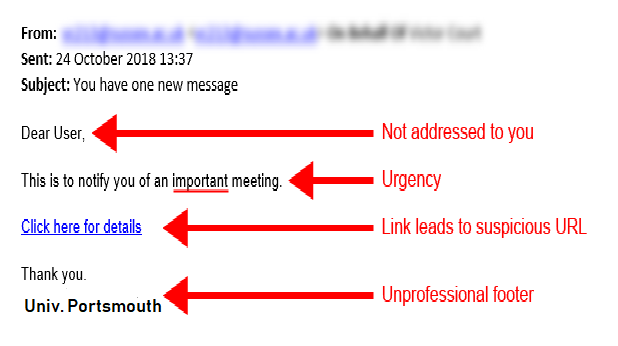It claims that there is an important meeting, and contains a link for details. The email may even use your name (so called ‘spear-phishing’). However, the link provided leads to a fake website designed to capture your login details so that your account can be hijacked. These sites can look very realistic.
Most of this advice can be used to identify more general “dodgy” emails – spams, scams, and attempts to spread malicious software.
Where is the link actually going to take me?
Move your mouse cursor so it hovers over the link. Now look at the bottom of the window, you should be able to see the URL of the destination site. Even to the non-expert, these URLs can look very suspicious, messy and not at all related to any known organisation – it’s a phishing site!
Here’s an example
Common phishing techniques:
- Begins with ‘Dear User’, ‘Dear Sir or Madam’
- Urgency – the message urges you to take action quickly – without thinking
- Surprising – e.g. Why is the Vice Chancellor asking me to pay an invoice?
- Fake link – the link leads to an unfamiliar and suspicious-looking URL
- Unprofessional Formatting
- Poor use of English
The use of any one of these in an email should increase your suspicion of it; the absence of some does not indicate that the email is trustworthy.
Reporting
If you receive a message like this, please delete it. If you’re ever concerned that an email might be malicious, or if you think you might have given your account details away, please contact the IS Service Desk on ext 7777 or send a report to the servicedesk@port.ac.uk email address.
If you do report a suspicious email, you may wish to take a look at obtaining the “original view“. There is a lot of extra information contained within email headers that can be useful for identifying the source of an email and normally forwarding an email loses such information.

